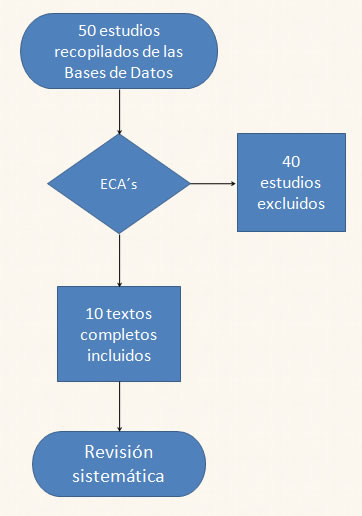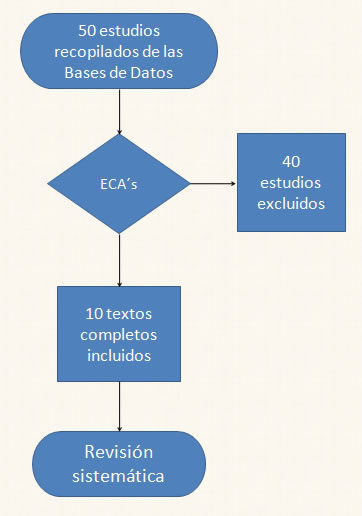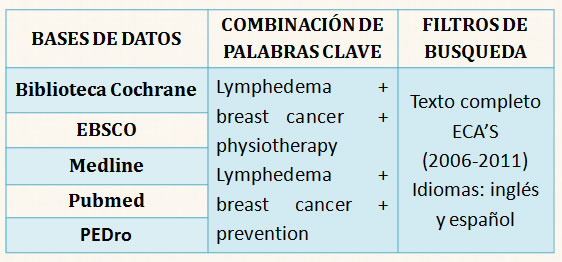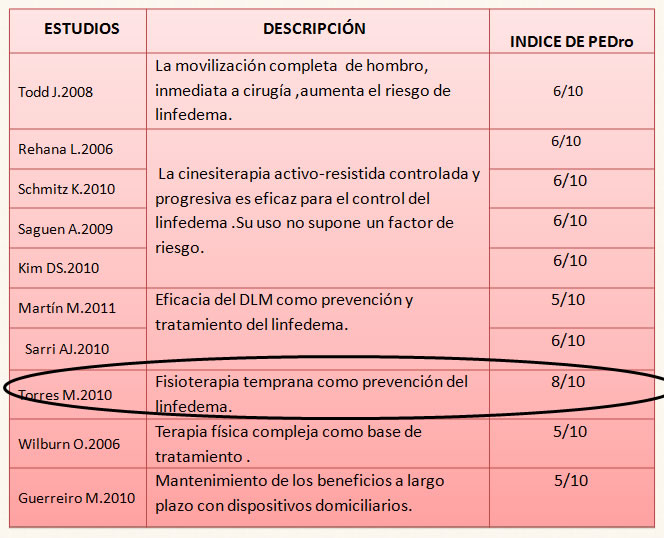
Autor:
González Calzada, Cristina.
Fisioterapeuta cl49-1999
Trabajo fin de grado, Universidad Rey Juan Carlos, año 2012.
1- Introducción
El linfedema, tras el tratamiento del cáncer de mama, es una complicación crónica, frecuente y angustiosa que afecta a un número significativo de mujeres dado el aumento de supervivencia en esta enfermedad.
El objetivo de esta revisión es analizar el estado actual de la fisioterapia como prevención y tratamiento y, por tanto, si existe consenso entre los autores para la elaboración de un protocolo de actuación eficaz.
2. Material y métodos
2.1 diagrama de flujos

2.2 tabla estrategia de búsqueda

Se revisaron los textos completos de las bases de datos Medline, Physiotherapy Evidence Database, Pubmed, Biblioteca Cochrane, SBESCO desde el año 2006 hasta el 2011 con restricción en el idioma (inglés y español). Se completó la búsqueda utilizando la web con base Google. Se utilizaron “lymphedema” y “breast cancer” como palabras clave principales y se añadieron otros términos como “physioterapy”y “prevention”.
Posteriormente, se seleccionaron los artículos con mayor evidencia científica. Incluyendo, únicamente, diez ensayos clínicos aleatorizados (ECA’s) en la revisión.
3. Resultados:

Destacable el estudio de Torres M. 2010 con una evidencia alta y buena calidad metodológica (8/10 en la escala PEDro). Importantes resultados positivos sobre la cinesiterapia activo-resistida progresiva tanto en prevención como tratamiento
Evidencia muy alta con buena calidad metodológica (8/10 en la escala PEDro) y convincente, en un protocolo de fisioterapia temprana como medida de prevención del linfedema. Importantes resultados positivos sobre la cinesiterapia activo-resistida progresiva tanto en prevención como tratamiento. El drenaje linfático manual presenta resultados contradictorios y débiles sobre su uso, mientras, la terapia física compleja sigue siendo la base del tratamiento.
4. Discusión
La fisioterapia precoz ha demostrado ser una herramienta eficaz de prevención del linfedema, en la que se incluyen diferentes técnicas como DLM, masaje de la cicatriz, estiramientos, ejercicios activo-asistidos, activo-resistidos progresivos y estrategia educacional. Sin embargo, son muy pocos los estudios que presentan esta clara diferencia entre prevención y tratamiento. Por otro lado, se prevé un importante cambio en la orientación del tratamiento hacia una terapia física en el que el uso del miembro afecto no sea un temor, mejorando la funcionalidad global y, por tanto, la calidad de vida de la paciente.
5.Conclusión
La fisioterapia es clave en la prevención y tratamiento del linfedema después del cáncer de mama, sin embargo, se necesitan más estudios para asentar estas diferencias, elaborando protocolos eficaces y ver, posteriormente, sus efectos a largo plazo.
BIBLIOGRAFÍA
(1) Manual lymph drainage when added to advice and exercise may not be effective in preventing lymphoedema after surgery for breast cancer. Journal of Physiotherapy 2011; 57:258.
(2) Armer JM, Brooks CW, Stewart BR. Limitations of self-care in reducing the risk of lymphedema: supportive-educative systems. Nurs Sci Q 2011; 24(1):57-63.
(3) Bani HA, Fasching PA, Lux MM, Rauh C, Willner M, Eder I, et al. Lymphedema in breast cancer survivors: assessment and information provision in a specialized breast unit. Patient Educ Couns 2007 06; 66(3):311-318.
(4) Barclay L. Exercise May Prevent Lymphedema after Breast Cancer. Am Inst Cancer Res Newsl 2011; 07(112):10-10.
(5) Barclay L. Early physiotherapy may help prevent lymphedema after breast cancer surgery. DISSECTOR 2010 03; 37(4):8-9.
(6) Box R. Restriction of the range of arm elevation exercises for one week after surgery for breast cancer can reduce the incidence of lymphoedema. Aust J Physiother 2009 03; 55(1):64-64.
(7) Braz da Silva NF, Angotti H, Franco K, Homsi C, Ferreira J. Physiotherapy Treatmet For Breast Cancer-Related Lymphedema: A Literature Review. Rev Latino-am Enfermagem 2009; 17(5):730-731-737.
(8) Cavanaugh KM. Effects of Early Exercise on the Development of Lymphedema in Patients With Breast Cancer Treated With Axillary Lymph Node Dissection. JOURNAL OF ONCOLOGY PRACTICE 2011; 7(2):89-90-93.
(9) Chan D, Lui L, So W. Effectiveness of exercise programmes on shoulder mobility and lymphoedema after axillary lymph node dissection for breast cancer: systematic review. J Adv Nurs 2010 09; 66(9):1902-1914.
(10) Cheifetz O, Haley L, Breast Cancer A. Management of secondary lymphedema related to breast cancer. Can Fam Physician 2010 Dec; 56(12):1277-1284.
(11) Cheville A. Prevention of lymphoedema after axillary surgery for breast cancer: physiotherapy shows promise in a selected group of women. BMJ BR MED J (Overseas & Retired Doctors ed) 2010 16; 340:b5235-b5235.
(12) Clemens K, Jaspers B, Klaschik E, Nieland P. Evaluation of the Clinical Effectiveness of Physiotherapeutic Management of Lymphoedema in Palliative Care Patients. Japanese Journal of Clinical Oncology 2010; 40(11):1068-1069-1072.
(13) Devoogdt N, Christiaens MR, Geraerts I, Truijen S, Smeets A, et al. Effect of manual lymph drainage in addition to guidelines and exercise therapy on arm lymphoedema related to breast cancer: randomised controlled trial. BMJ BR MED J (Overseas & Retired Doctors ed) 2011 09/24; 343(7824):625-625.
(14) Díaz O, García ML, Peguero Y, Mussendeni O, Otero M. Rehabilitación en atención primaria al paciente con linfedema posmastectomía. Revista Cubana de Medicina General Integral 2009;25(4):117-118-126.
(15) Finnane A, Liu Y, Battistutta D, Janda M, Hayes S. Lymphedema After Breast or Gynecological Cancer: Use and Effectiveness of Mainstream and Complementary Therapies. The Journal of Alternative and Complementary Medicine 2011; 17(9):867-868-869.
(16) Fleysher LA. Keeping breast cancer survivors lymphoedema-free. Br J Nurs 2010 07/08; 19(13):826-830.
(17) Flórez M VM. Eficacia del tratamiento conservador no farmacológico del linfedema postmastectomía. Rehabilitacion 2007; 41(3):126-127-134.
(18) Fu MR, Axelrod D, Haber J. Breast-cancer-related lymphedema: information, symptoms, and risk-reduction behaviors. J Nurs Scholarsh 2008 12; 40(4):341-348.
(19) Gomide LB, Matheus JP, FJ. Morbidity after breast cancer treatment and physiotherapeutic performance. Int J Clin Pract 2007 06; 61(6):972-982.
(20) González-Sánchez J, Sánchez-Mata F. Quality of life, rating scales, and lymphedema preventive measures [Spanish]. REhabilitation 2010 10/02; 44:44-48.
(21) Greenslade MV, House CJ. Living with lymphedema: a qualitative study of women's perspectives on prevention and management following breast cancer-related treatment. Can Oncol Nurs J 2006 2006;16(3):165-171.
(22) Guerreiro M, Helio A, Pereira de Godoy JM. Active exercises utilizing a facilitating device in the treatment of lymphedema resulting from breast cancer therapy. GMS German Medical Science 2010; 8:1612.
(23) Harmer V. Breast cancer-related lymphoedema: risk factors and treatment. Br J Nurs 2009 02/12;18(3):166-172.
(24) Karki A, Anttila H, Tasmuth T, Rautakorp U. Lymphoedema therapy in breast cancer patients . a systematic review on effectiveness and a survey of current practices and costs in Finland. Acta Oncologica 2009; 48:850-851-859.
(25) Kerry A. Sherman, PhD, and Louise Koelmeyer, BAppSc(OT). The Role of Information Sources and Objective Risk Status on Lymphedema Risk-Minimization Behaviors in Women Recently Diagnosed With Breast Cancer. Vol. 38, No. 1, January 2011 • Oncology Nursing Forum.
(26) Kim do S, Sim YJ, Jeong HJ, Kim GC. Effect of active resistive exercise on breast cancer-related lymphedema: a randomized controlled trial. Arch Phys Med Rehabil 2010 Dec; 91(12):1844-1848.
(27) Kim DS, Sim Y, Jeong HJ, Kim GC. Effect of Active Resistive Exercise on Breast Cancer–Related Lymphedema: A Randomized Controlled Trial. 2010; 91.
(28) Lacovara JE, Yoder LH. Secondary lymphedema in the cancer patient. Medsurg Nurs 2006 quiz 307; Oct; 15(5):302-306.
(29) Lafosse A, Vandeputte C, Sabor I, Mahaudens P, Denoel C. [About an extreme case of giant lymphoedema of the upper limb: ligasure may be useful and a multidisciplinary approach is mandatory]. Ann Chir Plast Esthet 2011 Aug; 56(4):325-328.
(30) Langbecker D, Hayes S.C, Newman B, Janda M. Treatment for upper-limb and lower-limb lymphedema by professionals specializing in lymphedema care. European Journal of Cancer Care 2008; 17:557-558-564.
(31) Lawenda B, Mondry T,Johnstone, P. Lymphedema: A Primer on the Identificationand Management of a Chronic Condition in Oncologic Treatment. CA Cancer J Clin 2009; 59:8-9-24.
(32) Leal Nf, Carrara HH, Vieira KF, Ferreira CH. Physiotherapy treatments for breast cancer-related lymphedema: a literature review. Rev Lat Am Enfermagem 2009 Sep-Oct; 17(5):730-736.
(33) Lee TS, Kilbreath SL, Sullivan G, Refshauge KM, Beith JM. Patient perceptions of arm care and exercise advice after breast cancer surgery. Oncol Nurs Forum 2010; 37(1):85-91.
(34) Martín M, Hernández MA, Avendaño C , Rodríguez F, Martínez H. Manual lymphatic drainage therapy in patients
with breast cancer related lymphoedema. Martín et al. BMC Cancer 2011;94(11):9 March 2011-1471-2407.
(35) McNeely ML. Early physiotherapy after surgery for breast cancer can reduce the incidence of lymphoedema in the following 12 months. J PHYSIOTHER 2010 06; 56(2):134-134.
(36) Meneses KD, McNees MP. Upper extremity lymphedema after treatment for breast cancer: a review of the literature. Ostomy Wound Manage 2007 May;53(5):16-29.
(37) Moseley AL, Carati CJ, Piller N. A systematic review of common conservative therapies for arm lymphoedema secondary to breast cancer treatment. Annals of Oncology 2007; 18:639-640-646.
(38) Pereira de Godoy JM, Guerreiro de Godoy MF. Godoy & Godoy technique in the treatment of lymphedema for under-privileged populations. International Journal of Medical Sciences 2010; 7(2):68-69-71.
(39) Rehana L. Ahmed, William Thomas, Douglas Yee, and Kathryn H. Schmitz. Randomized Controlled Trial of Weight Training and Lymphedema in Breast Cancer Survivors. june 20 2006 2006; 24(18).
(40) Sagen Å, Kåresen R, Risberg MA. Physical activity for the affected limb and arm lymphedema after breast cancer surgery. A prospective, randomized controlled trial with two years follow-up. Acta Oncol 2009 11; 48(8):1102-1110.
(41) Sanz M, F. Physiotherapeutic treatment in the upper limbs lymphoedema secondary to mastectomy [Spanish]. FISIOTERAPIA 2008 2008; 30(6):286-292.
(42) Sarri AJ, Moriguchi SM, Dias R , Peres SV , Tinóis da Silva E et al. Physiotherapeutic stimulation: Early prevention of lymphedema following axillary lymph node dissection for breast cancer treatment. 2011; 1:147-152.
(43) Schmitz K. Balancing Lymphedema Risk: Exercise Versus Deconditioning for Breast Cancer Survivors. Exerc Sport Sci Rev 2010; 38(1):17-18-24.
(44) Schmitz,KH, Troxel,AB, Cheville,A, Grant.L, Bryan,J , Gross.C et al. Physical Activity and Lymphedema (The PAL Trial): Assessing the safety of progressive strength training in breast cancer survivors. Contemp Clin Trials 2009; 30:233-234-245.
(45) Seifart U, Albert US, Heim ME, Hübner J, Jungkunz W, Prokein R, et al. [Lymphedema in patients with breast cancer--a consensus regarding diagnostics and therapy in patients with postoperative lymphedema after primary breast cancer] [German]. Rehabilitation (Stuttg) 2007 12; 46(6):340-348.
(46) Sherman KA, Koelmeyer L. The role of information sources and objective risk status on lymphedema risk-minimization behaviors in women recently diagnosed with breast cancer. Oncol Nurs Forum 2011; 38(1):E27-36.
(47) Shih YC, Xu Y, Cormier JN, Giordano S, Ridner SH, Buchholz TA, et al. Incidence, treatment costs, and complications of lymphedema after breast cancer among women of working age: a 2-year follow-up study. J Clin Oncol 2009 04/20; 27(12):2007-2014.
(48) Todd J, Scally A, Dodwell D, Horgan K, Topping A. A randomised controlled trial of two programmes of shoulder exercise following axillary node dissection for invasive breast cancer. Physiotherapy 2008 12;94(4):265-273.
(49) Torres M, Yuste MJ, Zapico A, Prieto DO, Cerezo E, Minayo E. Effectiveness of early physiotherapy to prevent lymphoedema after surgery for breast cancer: randomised, single blinded, clinical trial. BMJ BR MED J (OVERSEAS & RETIRED DOCTORS ED) 2010 16; 340:b5396-b5396.
(50) Wilburn O, Wilburn P, Rockson SG. A pilot, prospective evaluation of a novel alternative for maintenance therapy of breast cancer-associated lymphedema [ISRCTN76522412]. BMC Cancer 2006; 6:84.
